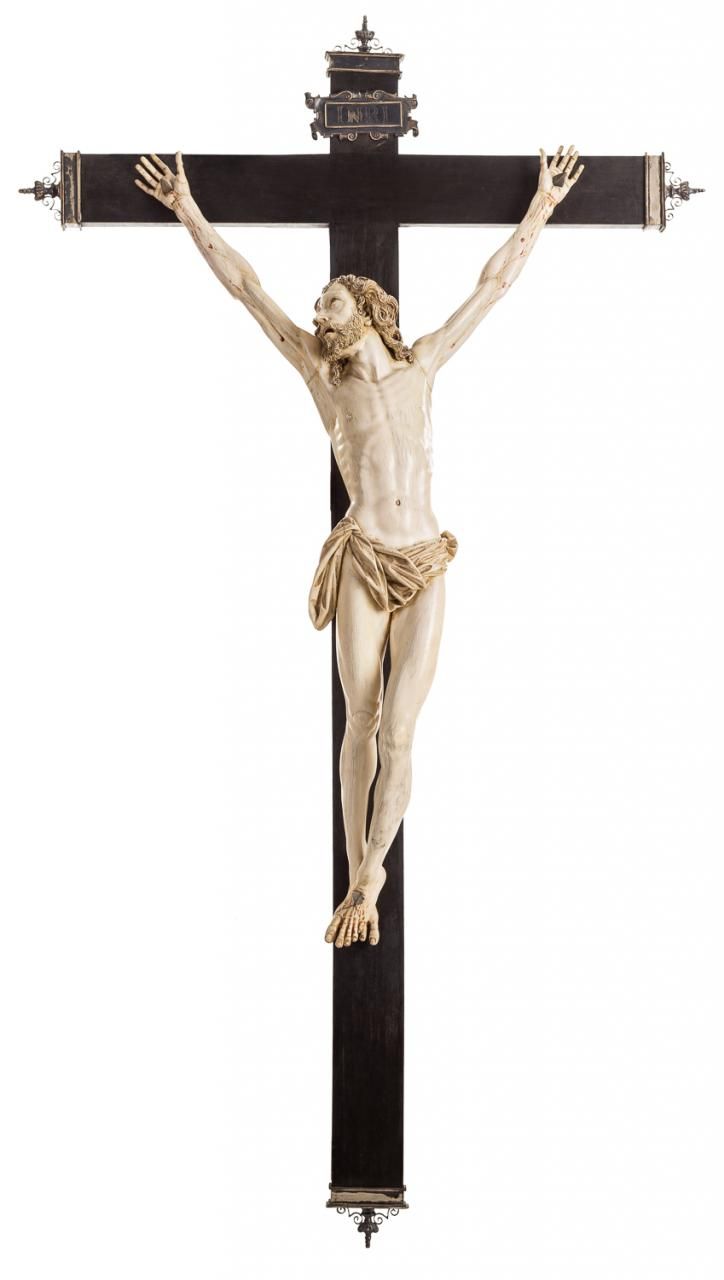Description
Christ Crucified in ivory carved on an ebonised wooden cross with silver corner pieces. Spanish School, ca. 1600 Cross: 122 x 69 cm / Christ: 82 x 45 x 14 cm Within European sculpture, ivory (a scarce and expensive product, difficult to procure) was reserved for works of small format - imposed by the characteristics of the material itself - and high technical quality, made by the best sculptors, both for the courtly and religious spheres. In the latter, the predominant theme will be the image of Christ on the cross, a highly appreciated and fundamental element in the decoration of the altars of churches and private chapels, monastic cells and halls and even in the halls of civil institutions and pious people. The Christ that occupies this cataloguing belongs to the Corpus Christi of an already early Baroque style, quite contained, characterized by a dramatic pathos with a raised face, disturbing eyes wide open and the mouth open that undoubtedly highlight the demand for realism enhanced in the religious sculpture of the time. Our expiring Christ stands out for its high quality and very large format, being its size uncommon. It is a crucified with three nails, carved in ivory in three pieces, two corresponding to the arms that are assembled at the height of the shoulders with the third one that includes from the head to the feet. It shows the head raised upwards and slightly turned to his right with his eyes raised and open. His mouth is also open and the marked frown accentuates his suffering even more. His hair, beard and curly moustache show detailed work with traces of polychrome. The arms raised vertically in a symmetrical way, together with the legs, are of a contained size that slightly marks the details of the musculature and finish off in hands and feet that are cared for in detail. The body presents a perfect anatomical detail and the purity cloth marks a curved line between the hips and the belly that folds adapting to the body. At the same time, we can detect traces of blood emanating from her feet and hands falling down her arms with marked veins. _x000D_. With an appraisal document from the Spanish Association of Antique Dealers.
797
Christ Crucified in ivory carved on an ebonised wooden cross with silver corner pieces. Spanish School, ca. 1600 Cross: 122 x 69 cm / Christ: 82 x 45 x 14 cm Within European sculpture, ivory (a scarce and expensive product, difficult to procure) was reserved for works of small format - imposed by the characteristics of the material itself - and high technical quality, made by the best sculptors, both for the courtly and religious spheres. In the latter, the predominant theme will be the image of Christ on the cross, a highly appreciated and fundamental element in the decoration of the altars of churches and private chapels, monastic cells and halls and even in the halls of civil institutions and pious people. The Christ that occupies this cataloguing belongs to the Corpus Christi of an already early Baroque style, quite contained, characterized by a dramatic pathos with a raised face, disturbing eyes wide open and the mouth open that undoubtedly highlight the demand for realism enhanced in the religious sculpture of the time. Our expiring Christ stands out for its high quality and very large format, being its size uncommon. It is a crucified with three nails, carved in ivory in three pieces, two corresponding to the arms that are assembled at the height of the shoulders with the third one that includes from the head to the feet. It shows the head raised upwards and slightly turned to his right with his eyes raised and open. His mouth is also open and the marked frown accentuates his suffering even more. His hair, beard and curly moustache show detailed work with traces of polychrome. The arms raised vertically in a symmetrical way, together with the legs, are of a contained size that slightly marks the details of the musculature and finish off in hands and feet that are cared for in detail. The body presents a perfect anatomical detail and the purity cloth marks a curved line between the hips and the belly that folds adapting to the body. At the same time, we can detect traces of blood emanating from her feet and hands falling down her arms with marked veins. _x000D_. With an appraisal document from the Spanish Association of Antique Dealers.
